In podcast #176, Pete, Belinkie and I talked about different builds in video games. A “build,” for the non-gamers, is an allocation of resources to one’s video game character toward a different tactical end. Call of Duty: Modern Warfare lets you equip your character with different weapons and equipment at the start of a multiplayer match, allowing a different style of play: a soldier with a silenced sniper rifle will engage her opponents differently from a soldier with an assault rifle with an extended clip. World of Warcraft, on the other end of the spectrum, asks new players to select a character class that determines the talents and strengths that will be available to them later. Both these games require players to put some tactical consideration into their build.
This has been going on for long enough that it’s blended into the background, but it’s an odd element of gameplay. Not every video game requires a build. Every time you fire up Super Mario Bros., or Sonic the Hedgehog, or Gears of War, you’re playing with the same character. Mario can get power-ups, becoming a different Mario than he was in the beginning – mushrooms to get bigger, flowers to spit fire – but these aren’t quite the same as different builds. There are no branching paths. The only decision in whether or not to get a Fire Flower is whether getting it would put you at risk of losing a life.
(Although one of the first NES games to offer different builds was the retconned, kit-bashed sequel to Super Mario Bros., in which the four selectable characters – Mario, Luigi, Toad and the Princess – had four different modes of play. Ahead of their time!)
In fact, when considered in light of the history of ludology, the entire notion of a build is odd. It introduces an element to gameplay beyond player skill or random chance: the effect of a tactical selection. The conceit of most competitive games is that all players are notionally equal, that luck has the potential to aid or afflict them all equally, that the rules are fair and that therefore the play of the game will be a sort of agon to determine who has the most skill. But now our two-dimensional playing field has a third dimension.
(I wavered back and forth on whether build should be considered a subset of skill, but I think they’re ultimately different. Skill means execution within the instance of play, but a build is something you settle on beforehand. You choose whether to go sniper or assault in MW3 in the calm minutes before launch. You choose whether to charge down an alleyway or take cover in the heat of the moment.)
The agon, for the newbies to Western classics, is the Greek contest of sport. It was typically associated with religious or civic festivals, where athletes, musicians and poets would compete in their chosen arts. Distinguishing oneself through competition was a pillar of Hellenic society. Like many aspects of the social order, the Greeks personified the competitive drive in the form of a god, also named Agon, represented in Olympia as a statue toting dumbbells.
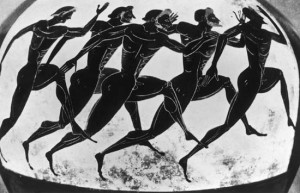
All the n00bs sprinting for the rocket launcher.
We know that two competitors in a sport might come from unequal starting points, and that’s fine. Hell, that’s expected – that’s why we have the contest in the first place, to find out who is farther ahead! But what about more formal games, like board games or games of chance? Why would a more casual game give its players different starting positions, and why?
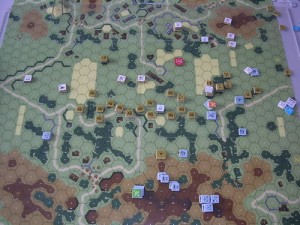
If we delve back far enough to find when unequal starting positions, or different builds, entered the ludological space, we find ourselves at wargames. War simulations have existed for as long as war, but modern wargames owe their patrimony to the Prussian army’s war simulator, Kriegspiel, and to “Little Wars,” H.G. Wells’ rules for playing with toy soldiers. Wargame enthusiasts collected miniatures, made up their own rules, and mocked up scale versions of historical battles. Since historical battles all had documented outcomes, and since verisimilitude is one of the chief concerns of most wargames, there were strong sides (whoever won in real life) and weak sides (whoever lost). You only picked the Confederacy in Avalon Hill’s Gettysburg if you wanted to start with a handicap, or if you wanted to indulge in a little historical revisionism.
In 1971, a group of Wisconsin wargamers who were recreating medieval battles decided to inject an element of Conan / Tolkien fantasy into their games. They brought in dragons, giants, wizards, halflings and elven rangers. Eventually these fantasy variations grew so popular that a couple referees, among them E. Gary Gygax and Dave Arneson, abandoned the small-unit combat aspect and focused instead on parties comprised of solo adventurers. This is when Chainmail, a packet of rules for medieval miniature combat, gave birth to Dungeons & Dragons, and from there the rest is history.
Computer roleplaying games were inspired by Dungeons and Dragons and aimed to simulate the same type of experience. Ultima and Wizardry (both 1981) let players design their own characters or outfit a party with different adventurers, which might be considered a sort of character gestalt. Final Fantasy popularized this style of game for the NES console. As video game RPGs grew more common, the notion of customizing a character before play began started to spread to other types of games. Hence we get MW3, about as far from a traditional JRPG as one can get and yet still spawning debates over custom classes.
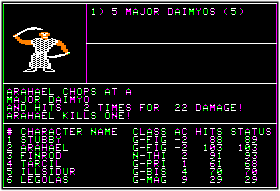
Much more fun than rolling dice with other humans.
I lay out all this history in order to trace the origins of builds back to their root cause. Builds ultimately owe their existence to the wargame hobby. You can trace a direct line from the assault class of MW3 to the chit-stacked tables of Advanced Squad Leader. And understanding this ancestry is crucial. As any serious minis hobbyist will tell you, the chief purpose of wargames is to start arguments; the secondary purpose is to paint miniatures; replicating battles is the least of a gamer’s concerns. And the more important a build is to your game of choice, the greater the ratio of time spent defending your build in online fora vs. time spent playing that build.
Why do builds matter? And why do we get so defensive over our builds?
As I asserted earlier, builds are a new variable in determining the outcome of a game, with skill and luck being the traditional two. The more that the outcome of a game relies on builds and luck, the less it relies on skill. Final Fantasy sits on the far end of the Build spectrum, where your party composition determines whether you can complete the game in a reasonable time or whether you will summon all the strength a 9-year-old can muster and snap a wooden folding chair in half after yet again dying on your way to the Marsh Cave (at least, that’s what I’ve heard people do). Super Mario Bros. sits on the far end of the Skill spectrum, with almost no random elements: every monster appears on the screen in a predetermined location and every power-up’s location can be documented in stone.
Both your build and your skill matter in whether and how quickly you succeed. And both build and skill require you to make choices. But the virtues of a build are academic and the virtues of your skill are circumstantial. We choose our builds for reasons (whether good or bad) but skill dictates the choices we make in the moment.
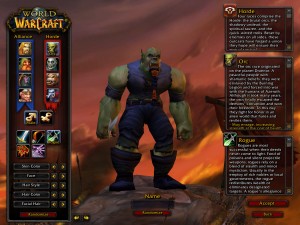
A game that requires builds opens up the field of competitors to more than just the quick and the perceptive. Even with a perfect map dictating the location of every power-up and a timing of a boss’s attack patterns down to the microsecond, you couldn’t beat Ninja Gaiden just by sitting in your armchair and developing a plan. You still need the reflexes and coordination to pull it off. Not so with Dragon Quest. Games with builds introduce a new virtue for successful play: deliberation.
In this way, builds are an obvious benefit in game design. Anything that makes a game accessible to more players is all to the good. But builds aren’t perfect.
Builds are arrived at through reason, whether good reasons (a consideration of the merits and flaws of a given set of equipment) or bad reasons (d00d snipers kick @$$). Reason is an argument we conduct with ourselves. It’s a rehearsal for the argument that we might one day have with another person (“why do you keep picking sniper?”) or perhaps with our future self (“why did I pick sniper again?”). It’s a short step from reason to rationalization.
You can’t argue with skill, just like you can’t argue with success. If one chessmaster defeats another, the loser can’t take to the mics at a press conference and say, “The rooks just weren’t feeling it today.” And we tend not to argue with the outcomes of skill. But we can argue about builds all day long.
Choosing your build is like choosing your path in life, albeit the short, violent life of a video game. Choosing a given play in the heat of the moment (i.e., exercising one’s skill) is not quite as momentous a decision. But, like choosing a build, it’s a choice. It’s a choice we make based on the information available to us, directed toward a given outcome. So why do we get so defensive about builds and so nonchalant about skill?
This treads into realms of psychology where I get a little weak, but I think part of it comes from the very personal nature of builds. Everyone wants to win at a game. Everyone wants to be skillful. There are no debates over the merits of competent vs. incompetent players. But people choose different builds for vastly different reasons. Some people pick snipers because they like the feel of hiding in an artificial nest, knocking people off while remaining untouchable. Some people play wizards because they like calling up waves of elemental force with a gesture. Some people play healers because they like the grim resolution of being the party member everyone needs to call on when the chips are down. All of these are valid choices and none of those reasons stop the build from being useful. A build allows a player to express their personality while on the way to winning.

To argue with a build is to argue with a player’s personality. It says, “I think the things you like are wrong.” Not morally wrong, like pederasty, but incorrect. This is a really tough statement to grapple with, if taken seriously. Imagine if I picked an argument with you over whether you liked vanilla or not. Or whether your preference for vanilla invalidated you as a person. “Only boring people like vanilla.”
The punch line, of course, is that this sort of thing is frighteningly common, especially on the Internet. We take people to task for harmless aesthetic choices all the time. “How could anyone like [that band / that movie / that book / that video game / that build]?” It seems so obvious when it rolls off our tongue – or, more accurately, off our fingertips and onto our keyboard. But it stings deep when it’s directed at us. The reason should be clear: we identify ourselves through the cultural elements that we like, and to challenge our liking is to challenge our self-identity.
A build is a way for us to imprint our personality onto a video game. A sniper’s experience of MW3 is very different from the assault class experience; a healer’s take on WoW differs from that of a ranger. The game is a stable property, but it presents different facets to us. Because of this, gameplay becomes more personal: my experience with MW3 is more uniquely mine because I customized my class.
And yet a build is not purely aesthetic, like the color of your Mii or your XBox Live gamertag. A build is also purpose-driven. You choose a build because you think it improves your chances of winning. The build you choose will be informed by your personality, but the end goal is always the same. And so into this level of harmless self-validation we add a bracing dose of external validation. If you stat out a sniper and your clan keeps getting shut out, then either your choice sucks (reflecting poorly on your personality) or you’re not playing a sniper well enough (which also reflects poorly).
Builds, then, are not just a continuation of the personal aesthetic into the medium of video games, but an evolution. Finally, we can do more than just assert our preferences into a marketplace of ideas: we can test them against a dynamic opponent. Vanilla and chocolate go head to head at last. It’s a substitute for the tests of status in the ancestral environment, or the agon of ancient Greece, or the wargames of miniature hobbyists who seek to out-Napoleon Napoleon. My ideas about how to play are not just my opinion; they’re right and what’s more, I can prove it. My ideas can beat your ideas.
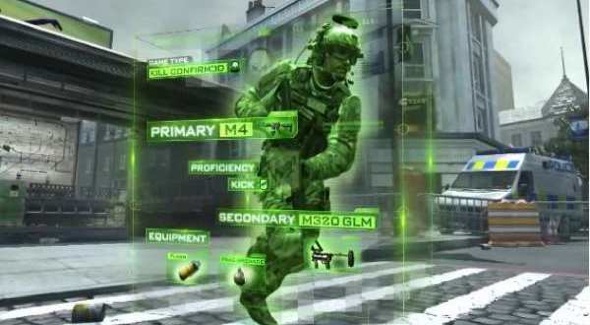
Does Oregon Trails fall into the category of games that start with a Build?
I would say so, yes.
Did the Carpenter or Farmer actually have unique abilities not available to the Banker? I can’t remember exactly, but I think they Banker, Carpenter, and Farmer simply corresponded to Easy, Normal, and Hard difficulties.
Now, I think Oregon Trail still does have builds, but they come up when the player determines what to spend their starting cash on. I used to roll hunter.
I recall, at least in some editions, that carpenters were better at maintaining and repairing a wagon, while farmers were better at finding food. Or maybe I was just rationalizing my choice of banker (“what? the other guys have their strengths!”).
I think there’s a distinction to be made between class and build. A class is something you choose before the game or your life starts. A build is how you choose to play the class you’ve picked.
Some games, Team Fortress 2 for example, almost force you to play the class as they’re meant to be played since you’re restricted to certain items. Other games, like League of Legends or the Diablo series, let you choose a character or class then build it however you want to, no matter how inefficient it may be.
Sirian, of Diablo 2 fame, was known for his extremely restricted hardcore builds, allowing himself only one or two offensive skills and definitely not how each class was meant to be built.
http://web.archive.org/web/20081228070614/http://sirian.warpcore.org/diablo2/diablo2.html
Interesting! Though I may use the two interchangeably in the piece, I mean “build” in the latter sense. In Sirian’s case, the build is almost an affectation – a style choice meant to flex his playing muscles.
Re:Diablo II, it seems that MongoJerry’s great narratives of the fighter sorceress and the barbarian mage are sadly no longer to be found on the internet.
I’m glad you mentioned SMB2; it was the first video game I ever finished to completion, and since then I’ve had a soft spot in my heart for it and any other Doki Doki derivatives.
It might be more in Fenzel’s area, but does the choice of Protoss, Zerg, or Terran in Starcraft represent that same idea of prior, deliberate action? Is there an interesting difference between picking a class in an RPG and a race in an RTS?
I lost hundreds of hours to StarCraft back in the day! Don’t even.
I would say, “yes, definitely.” Not only is your chosen race a matter of preference, but the way in which you develop them matters as well (do you go for a Zergling rush? climb the tech tree to Lurkers?).
See, what this makes me think of is Magic: the Gathering, where collecting and constructing your deck is such a huge part of the game. There are a bajillion articles up about how your magic deck reflects your personality or why you play. And then you have drafting, an attempt to make the build part of the game itself instead of something you do before you hit the table, and which challenges players to come up with the best build given limited resources and time. This in turn was developed into games where the build was the main part of the gameplay, e.g. Dominion… there’s really no end to this rabbithole.
A big difference about builds (and this is something Shamus Young has talked about) is that some builds can seriously impact on your ability to enjoy a game.
Consider someone who’s playing the game for fun, and they choose something because they like it. It’s probably not going to be optimal, they won’t be able to do the game properly (which is likely to assume you are min-maxing to a degree) and then have a terrible experience.
Conversely, those that know what they are doing will be Ultimate Build-ing, with the consequence of beating the game. (Which may or may not be fun, as tastes differ.)
And, this is a problem with the game, to some extent, in that it allows ‘crippled’ builds and then punishes the player for it.
Games that have builds give rise to guides about the ‘best’ way to build. And then it’s not so much ‘how do you build’ but ‘why didn’t you build this?’
I agree its a problem with the game design if their are crippled builds and the onus is on the player to follow the allegedly superior builds. On the other hand, by convention players often believe builds are crippled and never give them a real go. There is often a lot of pressure reinforcing these convention, since you can be booted from games/raids/guilds/teams. There is also a pressure to play your role. Back in the day ~2009 in WoW, for example, players were under the belief that druids should be party healers, despite being no better as healers than they were as tanks or dps. Their was failure to appreciate that their advantage is instant role switching rather than excelling in any single role. There is a feminist epistemology argument to be made here.
“As any serious minis hobbyist will tell you, the chief purpose of wargames is to start arguments; the secondary purpose is to paint miniatures; replicating battles is the least of a gamer’s concerns. And the more important a build is to your game of choice, the greater the ratio of time spent defending your build in online fora vs. time spent playing that build.”
Bravo. This is exactly one reason I do not hang out on gamer forums nor play wargames. Its also the case among milsim hobbyists who play airsoft, who are usually also FPS players and wargamers. They love how they are kitted out more than the actual advantage it gets them in game. Certainly they care about the advantage in game, but are willing to forego advantages, like camouflage or effective range, in order to have a kit quasi-accurately based on current US Special Forces gear. Its very aesthetic. I don’t necessarily have a problem with this. Its a roleplaying element and as someone who plays more dedicated tabletop roleplaying games I appreciate that in other domains; but, sometimes I wish these guys (I can’t think of a single girl like this) cared more about skill and social coordination and a little less about the aesthetics and historical connotations of the way their 1942 Russian issue binoculars are attached to to their assault vest. I believe it is the build mentality expressed in another medium.
The most build madness I’ve seen was in Anarchy Online. Because of the complex system of implants, buffs, and augmentations, one could develop intricate sequences that took hours and required the assistance of a dozen high level helpers to shoehorn highly advanced equipment onto low level characters who could then be used to farm level-capped special missions for unique items that were unavailable via any other method, and which were on restrictive spawn timers so they could be attempted only once every few days.
Well that was a long sentence. Now I have to go back to Strunk to re-buff my syntax dps.
I think the concept of build is old when you’re talking about team sports. Especially in something like American football, the management and coach have a lot of options in the build of the team: if they’re going to emphasize the running game vs. the passing game, how will they set up the defense, etc. Aesthetic and personality even play a role: “we’re a tough team in a tough city, so we pound it on the ground” or “our coach is a defensive genius so we highlight our complicated blitzes.” If it weren’t for comparing “builds”, ESPN commentators wouldn’t have much to talk about in the pre-games.
Along those sports lines, my first experience with builds was choosing players in NES Ice Hockey, trying to find the best balance of fat, skinny, and “normal” guys. Good times.
Mario 3 has an embryonic build system in that you can only have one second-tier powerup at a time. You can be fire Mario or Raccoon Mario, but not both.